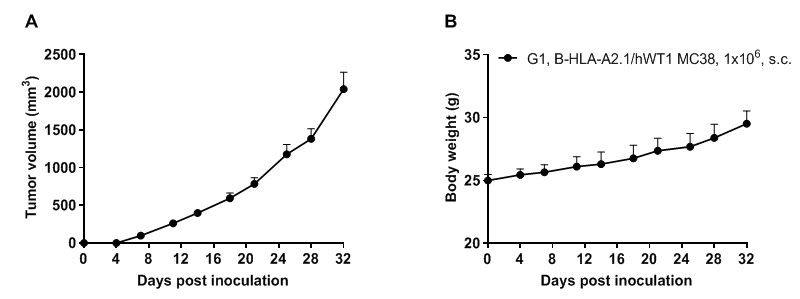B-HLA-A2.1/hWT1 MC38
|
Common name |
B-HLA-A2.1/hWT1 MC38 | Catalog number | 322362 |
| Aliases |
IMD43, AMYLD6, MHC1D4; HLAA; GUD, AWT1, WAGR, WT-1, WT33, NPHS4, WIT-2
|
Disease | Colon carcinoma |
|
Organism |
Mouse |
Strain | C57BL/6 |
| Tissue types | Colon | Tissue | Colon |
- Origin: The MC38 cell line is derived from C57BL/6 murine colon adenocarcinoma cells. The cell line is a commonly used murine model for colorectal carcinoma.
- Background Information: HLA-A belongs to the HLA class I heavy chain paralogues. This class I molecule is a heterodimer consisting of a heavy chain and a light chain (beta-2 microglobulin). The heavy chain is anchored in the membrane. Class I molecules play a central role in the immune system by presenting peptides derived from the endoplasmic reticulum lumen so that they can be recognized by cytotoxic T cells. The WT1 encodes a transcription factor that contains four zinc-finger motifs at the C-terminus and a proline/glutamine-rich DNA-binding domain at the N-terminus. It has an essential role in the normal development of the urogenital system, and it is mutated in a small subset of patients with Wilms tumor. This gene exhibits complex tissue-specific and polymorphic imprinting pattern, with biallelic, and monoallelic expression from the maternal and paternal alleles in different tissues. Multiple transcript variants have been described.
- Gene targeting strategy: The B2M gene (Exon2 to Exon3) of mouse were replaced by the sequence encompassing the human B2M CDS, HLA-A*0201 gene that included leader sequence, α1 and α2 domains ligated to a fragment of the murine H-2Db gene containing the α3, transmembrane and cytoplasmic domains and WT1 CDS. Human HLA-A2.1 is highly expressed on the surface of B-HLA-A2.1/hWT1 MC38. Human WT1 is highly expressed on the surface of B-HLA-A2.1/hWT1 MC38 cells.
- Application: B-HLA-A2.1/hWT1 MC38 tumor models can be used for preclinical evaluation of cancer vaccines.

HLA-A2.1 and WT1 expression analysis in B-HLA-A2.1/hWT1 MC38 cells by flow cytometry, respectively. Single cell suspensions from wild-type MC38 and B-HLA-A2.1/hWT1 MC38 #8-C07 cultures were detected with species-specific anti-HLA-A2.1 antibody (Biolegend, 343306) and anti-human WT1 (Abcam, ab89901), respectively. Human HLA-A2.1 was detected on the surface of B-HLA-A2.1/hWT1 MC38 cells but not wild-type MC38 cells(A). Human WT1 was detected in the B-HLA-A2.1/hWT1 MC38 cells but not wild-type MC38 cells(B).

Subcutaneous tumor growth of B-HLA-A2.1/hWT1 MC38 cells. B-HLA-A2.1/hWT1 MC38 cells (1×106) were subcutaneously implanted into B-HLA-A2.1 mice (male, 7-week-old, n=6). Tumor volume and body weight were measured twice a week. (A) Average tumor volume. (B) Body weight. Volume was expressed in mm3 using the formula: V=0.5 × long diameter × short diameter2. Results indicate that B-HLA-A2.1/hWT1 MC38 cells were able to establish tumors in vivo and can be used for efficacy studies. Values are expressed as mean ± SEM.

HLA-A2.1 and WT1 expression evaluated in B-HLA-A2.1/hWT1 MC38 tumor cells by flow cytometry, respectively. B-HLA-A2.1/hWT1 MC38 cells were subcutaneously transplanted into B-HLA-A2.1 mice (male, 7-week-old, n=6). Upon conclusion of the experiment, tumor cells were harvested and assessed with species-specific anti-HLA-A2.1 antibody (Biolegend, 343306) and anti-human WT1 (Abcam, ab89901), respectively. Human HLA-A2.1 was highly expressed on the surface of tumor cells(A). Human WT1 was detected in the tumor cells(B). Therefore, B-HLA-A2.1/hWT1 MC38 cells can be used for in vivo efficacy studies evaluating cancer vaccines.












 京公网安备:
京公网安备: